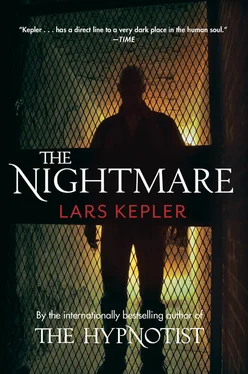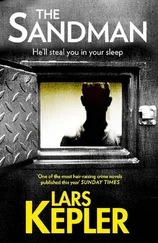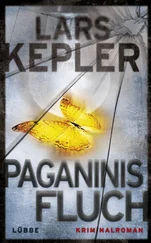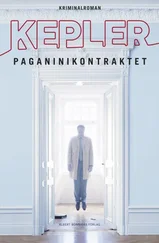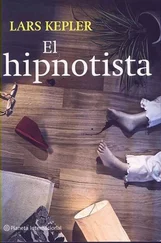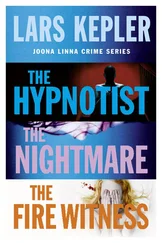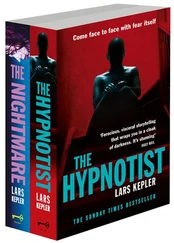Lars Kepler - The Nightmare
Здесь есть возможность читать онлайн «Lars Kepler - The Nightmare» — ознакомительный отрывок электронной книги совершенно бесплатно, а после прочтения отрывка купить полную версию. В некоторых случаях можно слушать аудио, скачать через торрент в формате fb2 и присутствует краткое содержание. Жанр: Триллер, на английском языке. Описание произведения, (предисловие) а так же отзывы посетителей доступны на портале библиотеки ЛибКат.
- Название:The Nightmare
- Автор:
- Жанр:
- Год:неизвестен
- ISBN:нет данных
- Рейтинг книги:5 / 5. Голосов: 1
-
Избранное:Добавить в избранное
- Отзывы:
-
Ваша оценка:
- 100
- 1
- 2
- 3
- 4
- 5
The Nightmare: краткое содержание, описание и аннотация
Предлагаем к чтению аннотацию, описание, краткое содержание или предисловие (зависит от того, что написал сам автор книги «The Nightmare»). Если вы не нашли необходимую информацию о книге — напишите в комментариях, мы постараемся отыскать её.
The Nightmare — читать онлайн ознакомительный отрывок
Ниже представлен текст книги, разбитый по страницам. Система сохранения места последней прочитанной страницы, позволяет с удобством читать онлайн бесплатно книгу «The Nightmare», без необходимости каждый раз заново искать на чём Вы остановились. Поставьте закладку, и сможете в любой момент перейти на страницу, на которой закончили чтение.
Интервал:
Закладка:
“All right,” Disa says. “You know what, Kaj, I think I’ll just hand you over to him directly.”
She hands the phone to Joona without saying a word.
“Joona Linna,” he says.
“Ah, Disa talks about you a great deal,” says Kaj Samuelsson. He sounds relaxed.
“A violin has only four strings,” Joona begins. “Logically, there are only a limited number of notes that can be played.”
“Where are you going with this?”
“The lowest note is the open G,” Joona continues calmly. “And somewhere there must be the highest note that-”
“Yes, good reasoning,” the professor says. “In 1636, the French scientist Mersenne published the Harmonie universelle. In that work, he posits that the best violinists can play one octave higher than the open string. This means the range can be from G to third E, which gives us altogether thirty-four notes in the chromatic scale.”
“Thirty-four notes,” Joona repeats.
“But if we go to musicians in the modern era, the range is greater due to new fingerings,” Samuelsson continues. He sounds amused. “And you can begin to count on reaching third A and have a chromatic scale of thirty-nine notes.”
“Keep going,” Joona says, watching Disa, who has gone off to look at some odd, jumbled-looking paintings displayed in a gallery window.
“However, when Richard Strauss expanded Berlioz’s Grand Treatise on Instrumentation and Modern Orchestration from 1904, fourth G became accepted as the highest possible note that could be reached by an orchestra violinist, which means forty-nine notes.”
Kaj Samuelsson laughs to himself at Joona’s impressed silence.
“Actually, we have yet to reach the highest possible note,” the professor explains. “And in addition, we now have flageolets and quarter tones.”
Disa and Joona are now strolling past a newly built replica of a Viking ship docked at Slottskajen as he speaks. They’re nearing Kungstradgarden.
“What about a cello?” Joona asks impatiently.
“Fifty-eight,” Samuelsson replies.
Disa is giving Joona a vexed look and points at an outdoor cafe.
“My real question is, if you were to look at a photograph of four musicians-two violins, one viola, and one cello-and if the image is clear, would you be able to tell, just from the placement of their fingers on the strings, which piece they’re playing?”
Joona hears Kaj Samuelsson mumbling to himself on the other end.
“There are so many alternatives, thousands…”
Disa shrugs and keeps walking without looking at Joona.
“Seven million combinations,” Kaj says at last.
“Seven million,” Joona repeats.
There’s silence on both ends of the phone.
“Yet on my photograph,” Joona goes on, his voice stubborn, “you can clearly see the fingers and the strings so that many alternatives could be eliminated immediately.”
“I’ll gladly take a look at your photo,” the professor replies. “But I would not be able to guess the notes, it’s just not possible and-”
“But-”
“Imagine, Joona Linna,” the professor continues happily. “Imagine you’ve actually figured out the approximate notes… How will you be able to tell from all the thousands of string quartets out there-Beethoven, Schubert, Mozart-which one is the correct composition?”
“I realize it might be impossible,” Joona says.
“Seriously, it is,” Kaj replies.
Joona thanks him for his time and goes to Disa, who is sitting on the rim of a fountain waiting for him. She lays her cheek on his shoulder as he sits down beside her. Just as he’s putting an arm around her, he remembers Robert Riessen’s words about his brother: If not even Axel could figure it out, no one can.
72
While Joona is quickly walking up on the Bragevagen sidewalk, he hears children happily yelling on the grounds of the German School.
He rings Axel’s doorbell and hears the melodious chime inside, but no one answers, and after waiting for a while, he decides to walk around the house. Suddenly he hears a screeching noise. He can see people standing in the shadow of a tree, and he pauses at a distance. A girl holding a violin stands on the marble patio. She looks about fifteen years old. Her hair is extremely short, and he can see some drawings she’s inked on her arms. Axel Riessen is with her, nodding and listening carefully as she drags the bow across the strings. Her movements look awkward, as if she’s holding the instrument for the very first time. Perhaps this is Axel’s daughter, or even his grandchild, because he watches her with such a gentle, curious expression.
The bow crosses the strings at the wrong angle and elicits a hissing, whining sound.
“It’s not in tune,” the girl says as an excuse for the terrible noise.
She smiles and, with care, hands the instrument back to Axel.
“Playing the violin means listening,” Axel says in a calm, friendly fashion. “The music is already inside you. You just release it into the world.”
He sets the violin to his own shoulder and begins to play the introductory melody to “Seguedille” from Bizet’s Carmen, then stops and holds out the violin to demonstrate.
“Now I’m going to tune these strings a little strangely, here… and here,” he says, and he turns the pegs a few times in different directions.
“Why are-”
“Now the violin is completely out of tune,” he continues. “And if I’d only learned how to play mechanically with exact fingering, then I would sound like this.”
He plays “Seguedille” again, and it is so terrible it’s almost unrecognizable.
“How pretty!” she says, joking.
“However, if you listen to the strings…” he says as he taps the E string. “Hear that? It’s much too low, but that makes no difference at all. You compensate by moving your finger farther up the fingerboard.”
Joona watches Axel Riessen put the violin back on his shoulder and play the piece again on the falsely tuned violin. He seems to use gymnastic fingering, but the piece is perfectly in tune.
“You’re a magician!” The girl laughs and claps her hands.
“Hello,” Joona says. He walks up and holds out his hand. Axel gathers the violin and bow together in his left hand and then shakes Joona’s hand. The girl shyly does the same.
He looks at Axel with his mistuned violin.
“That’s impressive.”
Axel shakes his head.
“As a matter of fact, I haven’t played for thirty-four years.” His voice sounds stiff as he says this.
“Do you believe that?” Joona asks the girl.
She nods and then she says mysteriously, “Don’t you see the glow around him?”
“This is Beverly,” Axel says in a low voice. “Beverly Andersson.”
Beverly gives Axel a big smile, and then she simply walks away between the trees.
Joona nods at Axel. “I need to talk to you.”
“Sorry about earlier, when I took off like that,” Axel says. He begins to retune the violin. “But something came up.”
“Not to worry-I just came back.”
Joona watches Axel, who, in turn, watches the girl pick some flowering weeds from the shaded lawn.
“Do we have a vase inside?” she calls out.
“In the kitchen,” Axel replies.
She carries her tiny bouquet of dandelions-white balls of fluff-into the kitchen.
“That’s her favorite flower,” Axel says as he listens closely to the G string. He adjusts the peg slightly and then sets the violin on the mosaic table.
“I’d like you to take a look at this,” Joona says, and he takes out the photograph from the folder.
They sit down at the table. Axel takes a pair of glasses from his front pocket and studies the photograph thoroughly.
Читать дальшеИнтервал:
Закладка:
Похожие книги на «The Nightmare»
Представляем Вашему вниманию похожие книги на «The Nightmare» списком для выбора. Мы отобрали схожую по названию и смыслу литературу в надежде предоставить читателям больше вариантов отыскать новые, интересные, ещё непрочитанные произведения.
Обсуждение, отзывы о книге «The Nightmare» и просто собственные мнения читателей. Оставьте ваши комментарии, напишите, что Вы думаете о произведении, его смысле или главных героях. Укажите что конкретно понравилось, а что нет, и почему Вы так считаете.
